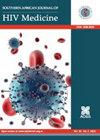Outcomes of Stevens–Johnson syndrome and toxic epidermal necrolysis in HIV-infected patients when using systemic steroids and/or intravenous immunoglobulins in Pietermaritzburg, South Africa
IF 1.6
4区 医学
Q4 INFECTIOUS DISEASES
引用次数: 7
Abstract
Background Stevens–Johnson syndrome (SJS) and toxic epidermal necrolysis (TEN) are severe life-threatening mucocutaneous reactions. There is an ongoing controversy regarding the use of systemic corticosteroids and intravenous immunoglobulin (IVIG) in SJS/TEN and their utility in HIV-infected patients. Objectives The objective was to assess the outcome of a combination of intensive supportive care with oral corticosteroids in SJS and a combination of systemic steroids and IVIG for 3 consecutive days in HIV-infected patients with TEN. In addition, we assessed management in a general dermatology ward without implementing wound debridement. Methods This was a retrospective cohort study of 36 HIV-infected adults with SJS/TEN admitted to a tertiary dermatology unit between 1st January 2010 and 31st July 2011. Standard-of-care protocols included identification and elimination of the possible causative drug, meticulous wound care without debridement, initiation of oral prednisone (1 mg/kg/day) on admission for 3 consecutive days, and the addition of IVIG (1 g/kg/day) for 3 consecutive days to those with TEN. Results Of the 36 patients in the study, 32 were female. Nevirapine was the commonest drug implicated. A diagnosis of tuberculosis did not increase the case fatality rate. Complications included infections, anaemia, drug-induced hepatitis, ocular involvement, renal impairment, deep vein thrombosis, respiratory distress, Leucopenia, gastritis and hypernatremia. The overall survival rate was 97%. Conclusion HIV-infected SJS and TEN patients were treated in a tertiary dermatology ward with a treatment plan of skin care, and a combination of systemic corticosteroids and IVIG respectively had a survival rate of 97%.南非彼得马里茨堡的史蒂文斯-约翰逊综合征和中毒性表皮坏死松解的hiv感染患者使用全身类固醇和/或静脉注射免疫球蛋白的结果
背景Stevens-Johnson综合征(SJS)和中毒性表皮坏死松解症(TEN)是严重的危及生命的粘膜皮肤反应。关于SJS/TEN中全身皮质类固醇和静脉注射免疫球蛋白(IVIG)的使用及其在HIV感染患者中的应用,目前仍存在争议。目的:评估SJS中口服皮质类固醇的强化支持性护理和全身性类固醇和IVIG联合治疗HIV感染的TEN患者连续3天的结果。此外,我们评估了在没有进行伤口清创的情况下,在普通皮肤科病房的管理。方法对2010年1月1日至2011年7月31日期间入住三级皮肤科的36名感染艾滋病毒的SJS/TEN成人进行回顾性队列研究。标准的护理方案包括识别和消除可能的致病药物,在不清创的情况下进行细致的伤口护理,入院时开始口服泼尼松(1 mg/kg/天)连续3天,并为TEN患者连续3天添加IVIG(1 g/kg/天)。结果36例患者中,32例为女性。奈韦拉平是最常见的毒品。肺结核的诊断并没有增加病死率。并发症包括感染、贫血、药物性肝炎、眼部受累、肾功能损害、深静脉血栓形成、呼吸窘迫、白细胞增多症、胃炎和高钠血症。总生存率为97%。结论HIV感染的SJS和TEN患者在三级皮肤科病房接受皮肤护理治疗,全身皮质类固醇和IVIG联合治疗的存活率分别为97%。
本文章由计算机程序翻译,如有差异,请以英文原文为准。
求助全文
约1分钟内获得全文
求助全文
来源期刊
CiteScore
2.80
自引率
11.80%
发文量
41
审稿时长
>12 weeks
期刊介绍:
The Southern African Journal of HIV Medicine is focused on HIV/AIDS treatment, prevention and related topics relevant to clinical and public health practice. The purpose of the journal is to disseminate original research results and to support high-level learning related to HIV Medicine. It publishes original research articles, editorials, case reports/case series, reviews of state-of-the-art clinical practice, and correspondence.

 求助内容:
求助内容: 应助结果提醒方式:
应助结果提醒方式:


